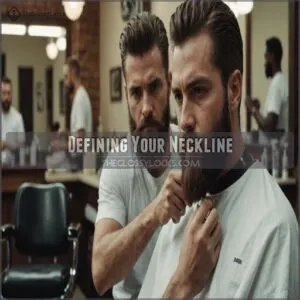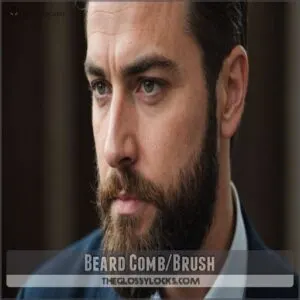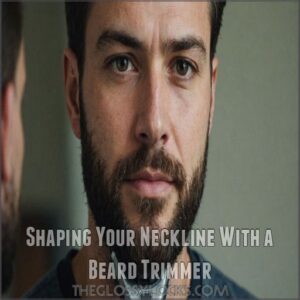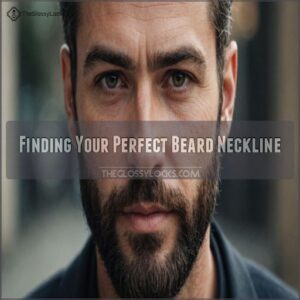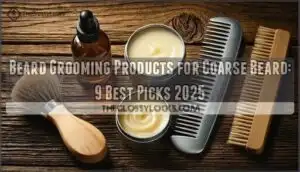This site is supported by our readers. We may earn a commission, at no cost to you, if you purchase through links.
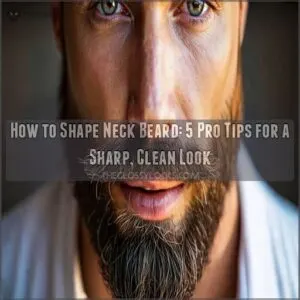 Ready to tame that wild neck beard? You’ve come to the right place! To shape your neck beard like a pro, start by finding your neckline. Place two fingers above your Adam’s apple – that’s your guide.
Ready to tame that wild neck beard? You’ve come to the right place! To shape your neck beard like a pro, start by finding your neckline. Place two fingers above your Adam’s apple – that’s your guide.
Trim everything below this imaginary line, keeping your trimmer parallel to your chin’s curve. Work outwards in the direction of your jaw, creating a symmetrical look on both sides.
Don’t forget to define the lowest point on your jawline for that sharp, clean appearance. It’s like sculpting, but instead of clay, you’re working with facial hair! With these tips, you’ll be well on your way to mastering the art of neck beard shaping. But wait, there’s more to discover about achieving that perfect look…
Table Of Contents
- Key Takeaways
- Defining Your Neckline
- Choosing The Right Tools
- Shaping Your Neckline With a Beard Trimmer
- Maintaining Your Neckline
- Finding Your Perfect Beard Neckline
- Frequently Asked Questions (FAQs)
- How to shape your beard neckline below your ears?
- What neck exercises can build neck strength?
- How do you shape up a beard?
- What is a ‘neck beard’?
- How do you make a beard neckline?
- How do you cut a neck beard?
- How should I shape my neck beard?
- How to shape a beard under the chin?
- How do you tame a neck beard?
- How to get rid of neckbeard?
- How often should I shape my neck beard?
- Can I shape my neck beard without professional help?
- Whats the best neckline for a short beard?
- How do I fix an uneven neck beard line?
- Should I shape my neckline before or after showering?
- Conclusion
Key Takeaways
- Define your neckline using the two-finger method above your Adam’s apple, creating a curved line from ear to ear for a clean, sharp look.
- Use the right tools, including a quality beard trimmer, razor, and aftercare products, to maintain your neckline and prevent skin irritation.
- To find the perfect neckline, consider starting at the natural crease between your head and neck, where your head meets your neck. Tailor your neckline to complement your face shape and beard length, adjusting it lower for fuller beards and higher for shorter stubble.
- Trim your neckline regularly, about twice a month, to keep it tidy without overdoing it, and always shape after showering for the best results.
Defining Your Neckline
You’re about to become a neck beard shaping pro, and it all starts with nailing your neckline.
Get ready to transform your scruffy look into a sharp, clean-cut style that’ll turn heads for all the right reasons.
Two Fingers Method
the two fingers method. Place your middle and index fingers above your Adam’s apple.
The line just above your fingers? That’s your sweet spot. It’s like giving your neck a high-five for the perfect beard shape.
Grab your trusty beard trimmer and follow this natural guideline. To achieve a sharp, clean neckline, use a quality beard trimmer with adjustable heads, and follow your natural jawline curves for precise trimming and adjustments learn how to trim neckline short beard. You’ll have a sharp, clean neckline faster than you can say "beard grooming master.
Double Chin Method
Got a double chin? No worries! Here’s a foolproof method to define your beard neckline.
Tilt your chin down in the direction of your neck, creating a natural fold. That’s your sweet spot!
Shave everything below this line for a crisp, clean look.
This technique works wonders for various facial structures and beard styles.
Remember, your beard trimmer is your best friend here.
With this double chin method, you’ll nail that perfect neckline every time. It’s like magic for your beard!
Pre-Shaving Tips
Now that you’ve mastered the double chin method, let’s prep your skin for a smooth shave.
Here’s your pre-shaving playbook:
- Splash warm water on your neck to soften those stubborn hairs
- Gently exfoliate to remove dead skin and prevent ingrown hairs
- Trim longer hairs with a beard trimmer for an even canvas
Remember, a well-prepped neck is half the battle won.
Think of it as laying the foundation for your beard masterpiece.
Your razor will thank you!
Shaving Techniques
You’ve prepped your skin, and now it’s time to tame that neck beard!
Shaving with the grain is your secret weapon against razor burn and ingrown hairs.
Picture your beard as a field of wheat – you want to go with the flow, not against it.
Here’s a quick guide to keep you on track:
| Technique | Benefits | Watch out for |
|---|---|---|
| Short strokes | Better control | Missed spots |
| Light pressure | Reduces irritation | Incomplete shave |
| Rinse blade often | Prevents clogging | Dull blade buildup |
Remember, a sharp blade is your best friend in this hairy situation!
Post-Shaving Care
After you’ve sculpted that perfect beard neckline, it’s time to show your skin some love.
Splash cold water to close those pores and prevent unwanted guests like razor burn and ingrown hairs.
Pat dry gently, then slather on some aftershave balm to soothe any irritation.
For the finishing touch, moisturize to keep your skin as smooth as your newly defined neckline.
Trust me, your beard will thank you!
Choosing The Right Tools
You’ll need the right gear to tame that neck beard, so let’s get your toolkit sorted.
From trimmers to razors, we’ll equip you with everything you need to sculpt a neckline that’ll make even the most discerning beard aficionado nod in approval.
Beard Trimmer
With the right beard trimmer, you’ll be sculpting that neckline like a pro in no time.
These versatile tools are your ticket to a sharp, clean look.
When choosing your trimmer, consider: how to trim neckbeard for the best results, especially when defining the neckline.
Cord or cordless options for flexibility, adjustable length settings to match your style, and wet/dry capabilities for shower-friendly grooming.
Remember, a quality trimmer is an investment in your look.
It’s like having a mini-barber in your bathroom, ready to help you tame that neck beard!
Razor
Let’s talk razors – your ticket to a clean, sharp neckline.
Safety razors offer precision but need a steady hand.
Cartridge razors are user-friendly and great for beginners.
Straight razors? They’re the big leagues, but boy, do they deliver a close shave.
Remember, blade sharpness is key to preventing razor burn. Always use fresh blades and pair ’em with a good shaving cream. Your neck will thank you!
Beard Shaper
Razors are great, but a beard shaper is your secret weapon for neckline perfection.
This nifty tool acts like training wheels for your beard, helping you nail those clean lines every time.
Here’s why you’ll love it:
- Versatility: Creates various neckline styles, from curved to step cuts
- Precision: Helps line up cheek lines and sideburns too
- Consistency: Makes sure symmetry on both sides of your face
Say goodbye to wonky necklines and hello to beard mastery!
Beard Comb/Brush
Now that you’ve got your beard shaper, it’s time to fine-tune your look with the right comb or brush.
These tools aren’t just for show – they’re your secret weapons for a polished neck beard.
If you’re looking for a high-quality option, consider checking out a boar bristle beard brush.
Let’s break down the differences:
| Tool Type | Best For | Maintenance |
|---|---|---|
| Wide-tooth Comb | Detangling | Rinse after use |
| Fine-tooth Comb | Styling | Clean with soap |
| Boar Bristle Brush | Distributing oils | Remove hair weekly |
| Synthetic Brush | Thick beards | Wash monthly |
| Wooden Comb | Reducing static | Oil occasionally |
Choose wisely, and you’ll be on your way to neck beard nirvana!
Mirror
Your beard-shaping toolkit isn’t complete without a good mirror.
It’s your window to precision.
Opt for a large, well-lit mirror that shows your entire face and neck.
For those hard-to-see spots, a handheld mirror is a game-changer.
Position it strategically to catch every angle.
Remember, proper lighting is key – natural light works wonders, but a lighted mirror can be your best friend for those early morning trims.
Shaping Your Neckline With a Beard Trimmer
You’re about to become a neckline-shaping pro with your trusty beard trimmer.
Get ready to transform your scruffy neck into a sharp, defined edge that’ll make your beard look intentional and well-groomed.
Trimming Technique
Got your tools ready?
Let’s tackle that neckline.
To get a clear view and perfect symmetry, use both bathroom and handheld mirrors for trimming.
Keep your chin up and stretch the skin tight under your jaw.
This gives you a smooth canvas to work with.
Start trimming from the bottom, working your way up.
Remember, slow and steady wins the race.
Don’t go too high, or you’ll end up with a chin-strap look.
Take your time and shape that neckline like a pro!
Length Settings
While mastering beard length is key, don’t overlook clipper settings for your neckline.
Set your beard trimmer two levels shorter than your main beard length.
This creates a smooth shift and prevents that dreaded "floating beard" look.
Here’s why nailing your trimmer guards matters:
- Boosts confidence with a clean, defined neckline
- Prevents itchy neck stubble
- Enhances your jawline’s natural shape
- Simplifies daily grooming routines
- Impresses with pro-level beard maintenance skills
General Neckline Guide
Picture a slightly curved line running from behind your ear lobes, under the jawline, to your Adam’s apple.
That’s your neckline sweet spot!
Grab your trusty beard trimmer and buzz everything below this imaginary line.
It’s like giving your neck a mini-makeover.
Remember, symmetry is key here.
Take it slow, step back often, and adjust as needed.
You’ll be rocking that sharp, clean neckline in no time!
Shaving With The Grain
Now that you’ve got your neckline mapped out, it’s time to tackle shaving with the grain.
This technique is your secret weapon against skin irritation and those pesky ingrown hairs.
Grab your beard trimmer and follow the natural hair growth direction.
Keep that blade angle gentle, about 30 degrees.
Don’t rush it – slow and steady wins the race here.
Your skin will thank you for the smooth, irritation-free result.
Creating a Neckline Fade
Ready to take your beard game up a notch? Let’s talk neckline fades. This style’s a real head-turner, blending your beard seamlessly into your skin.
Here’s how to nail it:
- Start with a longer guard on your beard trimmer
- Gradually decrease the guard length as you move down
- Use the shortest setting for the bottom of your neckline
- Blend the changes for a smooth fade
Remember, practice makes perfect. You’ll be rocking that fade in no time!
Maintaining Your Neckline
You’ve shaped your neckline, but the real challenge is keeping it looking sharp.
Let’s explore some pro tips to maintain that clean, defined look and avoid the dreaded "neckbeard gone wild" syndrome.
Shaving Cream
You’ve shaped your beard, now let’s talk lather.
Shaving cream is your secret weapon for a smooth neckline.
Apply a dime-sized amount to your wet skin, working it into a rich foam.
For an even better experience, try a shaving cream for neck specifically designed for this sensitive area shaving cream for neck.
This lubricates and protects, reducing irritation.
Can’t find your go-to cream? No sweat! Try hair conditioner or coconut oil as substitutes.
Remember, a well-prepped neck is half the battle won in your quest for a sharp, clean look.
Neckline Style
Your beard neckline style can make or break your look.
Consider your face shape and beard length when choosing.
Round faces benefit from a lower neckline, while square faces rock a higher one.
For a natural look, try a gentle curve.
Want a sharp edge?
Go for a straight line.
Experiment with fades for a seamless blend.
Remember, your neckline’s the frame for your beard masterpiece!
Mistakes
Even with the perfect neckline style, shaping mistakes can happen.
Don’t worry, we’ve all been there!
If you slip up while trimming, put down the beard trimmer and step away from the mirror.
Let’s tackle some common neckline blunders and their fixes:
- Trimming too high: Creates a double-chin effect
- Uneven lines: Makes your beard look lopsided
- Over-trimming: Leaves patchy spots or bald patches
Remember, patience is key.
If you make a mistake, give it time to grow back before attempting a fix.
Aftercare
Mistakes happen, but aftercare’s where the magic happens.
Close those pores with a splash of cold water or alcohol-free aftershave.
Treat your beard like royalty – use beard wash, shampoo, oil, and balm to keep it nourished and hydrated.
These products are your secret weapons against skin irritation, razor bumps, and ingrown hairs.
Think of it as pampering your neck’s throne – your beard will thank you with a kingly appearance.
Finding Your Perfect Beard Neckline
You’re about to discover the secret to a sharp, defined beard that’ll turn heads.
Finding your perfect beard neckline isn’t just about looks – it’s the key to transforming your facial fuzz from scruffy to suave in no time.
Importance of a Trim Neckline
From the moment you step out, a trim neckline can make or break your beard game.
It’s not just about looking sharp; it’s about feeling confident and in control.
A well-groomed neckline:
- Defines your jawline, giving your face a sculpted look
- Prevents the dreaded "neckbeard" effect
- Enhances your overall style and professionalism
- Keeps your beard hygienic and tidy
- Boosts your confidence, making you feel like a beard boss
Mastering this grooming skill is your ticket to beard greatness.
Determining The Neckline
Now that you know why a trim neckline matters, let’s nail down where it should be.
Imagine this: tilt your head down and find that natural crease where your neck meets your jaw.
That’s your ideal neckline sweet spot.
For a quick trick, place two fingers above your Adam’s apple – the line above your fingers is where your beard should end.
Easy peasy!
Face Shape and Neckline
Ever wonder how your face shape affects your beard neckline?
If you’ve got a round face, aim for a lower neckline to create a sharper jawline.
Square-faced? Rock a higher neckline to accentuate those chiseled features.
Oval and heart-shaped faces are lucky – most neckline styles work well.
For long faces, keep it balanced with a moderate neckline.
Remember, your beard trimmer is your best friend in crafting that perfect neckline for your unique face shape.
Beard Size and Neckline
Your beard’s size plays a big role in nailing that perfect neckline.
For fuller beards, go for a lower neckline to add depth and avoid the "floating head" look.
Shorter stubble? Keep it higher to define your jawline.
Remember, it’s all about balance – your neckline should complement your face shape and beard length.
Experiment with different heights to find your sweet spot.
Don’t be afraid to adjust as your beard grows!
Tools for Trimming
Every beard enthusiast needs the right tools to tame their neck fuzz.
Let’s take a closer look at the essentials that’ll have you looking sharp in no time.
Here’s your toolkit for neckline perfection:
- Electric edgers: Your go-to for precise outlines
- Adjustable clippers: Perfect for various beard lengths
- Beard shaper: A handy template for consistent necklines
With these tools, you’ll be mastering your beard neckline like a pro.
Remember, practice makes perfect, so don’t be afraid to experiment!
Frequently Asked Questions (FAQs)
How to shape your beard neckline below your ears?
Just as ears frame your face, they’re key to shaping your neckline.
Imagine a curved line from behind each earlobe, dipping under your jaw to your Adam’s apple.
Trim below this line for a sharp, defined look.
What neck exercises can build neck strength?
To build neck strength, try these exercises: neck flexion, extension, and rotations.
Side-to-side tilts and isometric holds work wonders too.
Start slowly, focusing on proper form.
Remember, a strong neck isn’t just for looks—it’s your head’s support system!
How do you shape up a beard?
Trim, shape, and sculpt your beard like a pro.
Define your neckline using the two-finger method, then grab your trimmer.
Start low, work your way up, and blend carefully.
Don’t forget to moisturize for that polished, dapper look.
What is a ‘neck beard’?
A neck beard is commonly paired with a full-length beard, which provides the most coverage and effectively conceals neck features, such as a double chin or weak chin styling tips. A neck beard is facial hair that grows below your jawline and on your neck.
It’s often seen as unkempt if left untrimmed.
You’ll want to shape it for a cleaner look and to avoid the "caveman" vibe.
How do you make a beard neckline?
Creating a sharp beard neckline‘s a breeze.
Find your Adam’s apple, place two fingers above it, and imagine a curved line from ear to ear.
Trim below this line, blending gradually.
You’ll look dapper in no time!
How do you cut a neck beard?
Define your neckline first using the two-finger method above your Adam’s apple.
Wet your beard, trim long hairs with an electric trimmer, then use a sharp razor.
Shave with the grain, moisturize after.
You’ll look sharp in no time!
How should I shape my neck beard?
By jove, shaping your neck beard’s a cinch!
Find your Adam’s apple, place two fingers above it, and that’s your neckline.
Trim below that line, keeping it curved.
You’ll look sharp as a tack in no time!
How to shape a beard under the chin?
To shape your beard under the chin, tilt your head down and find the natural crease.
Trim everything below this line using a trimmer or razor.
Aim for a smooth curve that follows your jawline for a polished look.
How do you tame a neck beard?
Whoa, Nelly! Taming your neck beard isn’t rocket science.
Trim it regularly with a beard trimmer.
Define a clean neckline.
Use beard oil to soften those unruly hairs.
You’ll look sharp in no time!
How to get rid of neckbeard?
Tame that wild neckbeard by defining your neckline first.
Use the two-finger method above your Adam’s apple.
Trim with a quality beard trimmer, shave with the grain, and moisturize.
Regular maintenance keeps you looking sharp and itch-free.
How often should I shape my neck beard?
Like Goldilocks finding the perfect porridge, you’ll want to shape your neck beard just right.
Aim for twice a month to keep it tidy without overdoing it.
This rhythm helps prevent irritation while maintaining that sharp, defined look you’re after.
Can I shape my neck beard without professional help?
You can shape your neck beard at home with the right tools and techniques.
Use a trimmer, define your neckline using the two-finger method, and trim carefully.
With practice, you’ll master this DIY grooming skill in no time.
Whats the best neckline for a short beard?
For a short beard, opt for a slightly curved neckline that follows your jaw’s natural contour.
Trim about two fingers above your Adam’s apple, creating a clean, defined look that enhances your jawline without appearing too manicured.
How do I fix an uneven neck beard line?
Uneven neckline? No sweat.
Let it grow for a week, then trim with care.
Use a beard trimmer on the longest setting, gradually decreasing.
Follow your natural neckline, and remember: patience is key.
You’ve got this!
Should I shape my neckline before or after showering?
By Jove, you’ll want to shape your neckline after showering!
The warm water opens your pores and softens your beard, making it easier to trim.
You’ll get a cleaner, more precise line with less irritation.
It’s a game-changer!
Conclusion
By a stroke of luck, you’ve stumbled upon the key to mastering how to shape neck beard like a pro. Armed with these five tips, you’re ready to transform your look from scruffy to sharp.
Remember, practice makes perfect, so don’t be discouraged if your first attempt isn’t flawless. Embrace the journey of finding your ideal neckline, and soon you’ll be turning heads with your well-groomed appearance.
Keep experimenting, stay patient, and before you know it, you’ll be the go-to guru for neck beard shaping advice.

